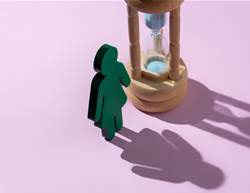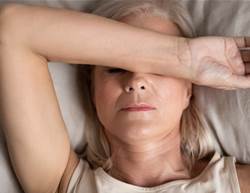If you’ve ever had one, you know there’s nothing quite like a hot flush. You might be putting away your groceries, sitting down for a meeting, or in the middle of a good dream when suddenly the skin around your face, neck and chest feels like it’s on fire. At the same time, your heart rate can spike, you may break out in a sweat, and then—just as quickly—you’re hit with a wave of chills once it’s over. Fun, right?
While hot flushes are most often linked to menopause and perimenopause, women and men of any age can experience them, says women’s health expert Beth Battaglino. “Hot flushes can strike at any time and for a lot of different reasons,” she says.
It’s also worth noting that having one doesn’t always signal anything serious, says Dr Alexandra Sowa. “It’s not clear why some people experience them and some don’t, but for many it’s a benign or short-lived condition,” she explains.
There are several possible reasons for hot flushes. Here are the most common triggers and what you can do about them.
1. Menopause
It’s no secret that menopause is the most common cause of hot flushes. During menopause, your ovaries stop releasing eggs and your oestrogen and progesterone levels drop. “It is this decrease in hormones that is thought to be the reason behind hot flushes,” says women’s health expert Jennifer Wide.
How to cool off: If your symptoms are severe, your doctor might suggest hormone replacement therapy (HRT)—a treatment that usually comes in the form of tablets, skin patches, creams and gels, or a vaginal ring—to help balance your hormone levels and ease hot flushes and other menopausal symptoms like night sweats. However, HRT isn’t suitable for everyone, as it can carry side effects and risks for some women. It’s best to discuss all your options with your GP or gynaecologist before committing to treatment.
2. Prescription medicines
Hot flushes can be a side effect of many common prescription medicines, such as opioids, antidepressants and some osteoporosis medications, says Dr Lynn Simpson. Certain steroids used to treat inflammation can also trigger hot flushes.
Beth Battaglino recommends paying attention to any symptoms that appear soon after starting a new medicine. “If they coincide, you’ll know that’s probably the cause,” she says.
How to cool off: Let your healthcare provider know what’s going on. They may be able to switch you to a similar medicine that doesn’t leave you feeling overheated. “It may also be that the hot flushes will go away as your body adjusts to the medication, so your provider can reassure you the discomfort won’t last long,” Battaglino adds.
3. A warm sleep environment
Your body temperature naturally fluctuates throughout the night, Dr Simpson says. So it’s common to wake up feeling overheated or sweaty. Sometimes, sleeping in a room or bed that’s too warm can be the trigger.
How to cool off: “It may be as simple as turning down the thermostat or sleeping with fewer blankets or lighter clothing,” Dr Simpson says. Keeping your bedroom between 16 and 19°C can help prevent overheating. Cooling sheets, pillows or lightweight quilts can also make a difference in avoiding night sweats.
4. Excess weight
Because carrying excess weight can interfere with your metabolism, it can also contribute to hot flushes, Battaglino says. If you’re overweight or gain weight during menopause, you’re even more likely to experience them. “Newer studies have shown that hot flushes may be more common in women who gain weight during menopause,” Dr Wider says.
How to cool off: Eating nutrient-rich foods and being more physically active can help relieve hot flushes, particularly if you’re overweight or obese. Research published in the journal Menopause suggests that a plant-based diet may also reduce the severity of hot flushes while supporting weight loss.
5. Anxiety and stress
Anxiety disorders can trigger symptoms like a racing heart, fidgeting, rapid breathing and hot flushes, Battaglino says. Hot flushes start in the brain, which is also where feelings of anxiety and stress originate. “Whatever mitigates anxiety in the brain triggers hot flushes, but we don’t know the exact mechanism,” says obstetrician–gynaecologist Dr Yvonne Bohn. If you already deal with hot flushes, stress and anxiety can make them worse, and the cycle can feed on itself.
How to cool off: “Reminding yourself to breathe is a simple exercise that can help calm anxiety,” Battaglino says. Natural approaches such as exercise, meditation and yoga can also promote relaxation and potentially reduce the severity of hot flushes. If these strategies don’t bring relief, you may be dealing with a more serious form of anxiety and should speak to your GP or a cognitive behavioural therapist about a treatment plan.
6. Medical conditions
Almost any health issue that affects your hormones can cause menopause-like symptoms, including hot flushes. Thyroid disorders—particularly an overactive thyroid—can be a culprit, Battaglino says. Infections or viruses may also trigger them, Dr Sowa explains.
If your thyroid is overactive, you may notice other symptoms in addition to hot flushes, such as a rapid heartbeat, unexplained weight loss, frequent urination and unusual fatigue.
When infections are to blame, Dr Sowa says you may also experience fever, diarrhoea or abdominal discomfort alongside your hot flushes.
How to cool off: If you notice unusual symptoms in addition to hot flushes, see your GP for a diagnosis and tailored treatment plan.
7. Breast cancer treatment
Hot flashes and night sweats can also be a side effect of breast cancer treatment, according to the National Cancer Institute. Radiation and chemotherapy can cause premature menopause in younger women, while older women may enter menopause as a result of chemotherapy.
“It has to do with hormone levels,” says Dr Wider, and how different cancer treatments affect them. For example, taking the oestrogen-modulating drug tamoxifen can lower oestrogen levels and trigger hot flushes. Certain procedures, like an oophorectomy (surgical removal of one or both ovaries), can also cause low oestrogen levels and lead to hot flushes, Dr Wider says.
How to cool off: To manage symptoms, limit spicy foods and hot drinks, avoid hot showers, saunas and triggers like stress and alcohol. Take a cool shower before bed and lower your bedroom temperature. Choose sleepwear and bedding made from natural fabrics such as cotton, linen or silk.
How to stop hot flashes from taking over your life
If hot flushes are a regular issue, check in with your GP to determine the cause. If low oestrogen is to blame, your doctor may recommend an oestrogen supplement or an antidepressant, Dr Bohn says.
Lifestyle changes can also help. Wear light, loose clothing to bed, keep your home cool and drink plenty of water, Dr Wider says. Keeping a diary of your hot flushes—recording the time, what you were doing and what you ate or drank beforehand—can help you identify possible triggers such as red wine or stress, Dr Simpson adds.
While it may not be possible to prevent hot flushes entirely, taking these steps can reduce how often they occur and how severe they feel.








.png&h=193&w=250&c=1&s=1)
.png&h=193&w=250&c=1&s=1)
